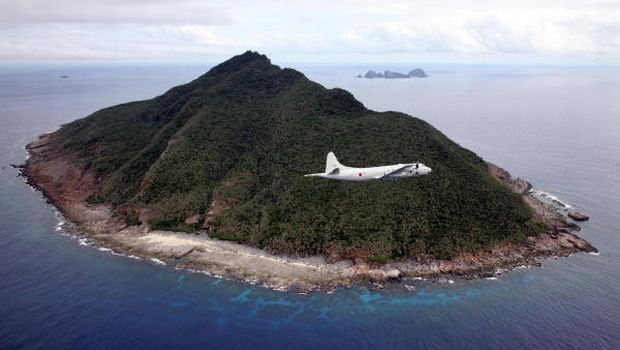
This photo taken on October 13, 2011 shows a P-3C patrol plane of the Japanese Maritime Self-Defense Force flying over the disputed islets in the East China Sea known as the Senkaku islands in Japan and Diaoyu islands in Chinaز (AFP PHOTO/JAPAN POOL via JIJI PRESS JAPAN OUT)
The move came after Tokyo’s close ally Washington defied China’s demand that airplanes flying through its unilaterally announced zone identify themselves to Chinese authorities, flying two unarmed B-52 bombers over the islands on Tuesday without informing Beijing.
Tensions have ratcheted up since Beijing’s weekend announcement of the zone that includes the skies over islands at the heart of a feud between Japan and China, and its demand that planes flying in the area first notify Chinese authorities.
Japan and the United States have sharply criticized the move, which some experts said was aimed not only at chipping away at Tokyo’s control of the islands, known as the Senkaku in Japan and the Diaoyu in China, but also at challenging US dominance in the region.
The United States does not take a position on the sovereignty of the islands but recognizes Tokyo’s administrative control and has assured Japan that the US–Japan security pact covers them.
The developments are expected to dominate US Vice President Joe Biden’s visit to Japan, China and South Korea next week.
Also on Thursday, China rejected South Korea’s demand for the repeal of the zone, but appeared to soften its demand that commercial aircraft tell its military authorities of any plans to transit the area. Japan’s two biggest airlines have already begun defying that order.
“The East China Sea Air Defense Identification zone is not aimed at normal international flights. We hope that relevant countries’ airlines can proactively cooperate, so there is more order and safety for flights,” China’s Foreign Ministry spokesman Qin Gang told reporters.
Japan’s Chief Cabinet Secretary Yoshihide Suga said naval ships and patrol planes have been operating in the East China Sea and would continue to do so.
“They are carrying out surveillance activity as before in the East China Sea, including the zone,” Suga told a news conference, adding there has been no particular response from China. “We are not going to change this (activity) out of consideration to China,” he added.
A South Korean official also said a navy reconnaissance plane had flown over a submerged rock in the area claimed by both Beijing and Seoul, and that the flights would continue.
The rock, called Ieodo in Korea and Suyan Rock in China, is controlled by South Korea, which maintains a maritime research station built on it.
Asked about the South Korean flight, Chinese spokesman Qin only said that Beijing was aware of it.
South Korea’s reaction to Beijing’s weekend declaration has been somewhat muted, reflecting its efforts to forge closer ties with China and a chill in relations with Japan.
On Thursday, however, Seoul’s vice defense minister told a senior Chinese military official that the move to impose the new rules created military tension in the region and called on Beijing to rectify the zone
“The Chinese reaction was that they will not be accepting the (South) Korean side’s demand,” Defense Ministry spokesman Kim Min-seok told reporters after talks between Vice Defense Minister Baek Seung-joo and Wang Guanzhong, the deputy chief of general staff of the Chinese People’s Liberation Army.
Asked if China would heed Japanese calls to revoke the air defense zone, China’s Defense Ministry spokesman Yang Yujun said Tokyo had implemented its own zone in 1969 and blamed it for raising tensions with its double standards.
“Japan consistently blames others and smears the name of other countries but never examines its own conduct,” Yang said in a statement posted on the ministry’s website after a press briefing that was closed to foreign reporters.
“If they want it revoked, then we would ask that Japan first revoke its own air defense identification zone and China will reconsider it after 44 years,” Yang said.
Japan says it only requires planes headed for its territorial air space to notify authorities, not those merely transiting through its air defense identification zone.
In the ongoing war of words, the policy panel of Japanese Prime Minister Shinzo Abe’s Liberal Democratic Party approved a resolution on Thursday demanding China rescind the new air defense zone, saying the unilateral move reflected “unreasonable expansionism”. But the resolution dropped a more inflammatory reference to “pre-modern and imperialist expansionism” contained in an earlier draft.
